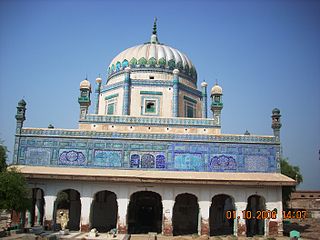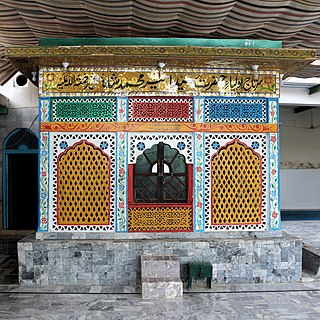
Multan is a city in Punjab, Pakistan, located on the bank of Chenab River. Multan is one of the five largest urban centres of Pakistan in 2024 and is the major cultural, religious and economic centre of Southern Punjab. Multan is known for its rich ancient heritage and historic landmarks. The city is one of the oldest inhabited cities of Asia, with a history stretching deep into antiquity. A historic capital of Punjab and a significant cultural centre of Indus Valley civilization. Multan region was centre of many civilizations in its 5 millennia old history.

Ghiyath al-Din Tughluq, or Ghazi Malik was the Sultan of Delhi from 1320 to 1325. He was the first sultan of the Tughluq dynasty of the Delhi Sultanate. During his reign, Ghiyath al-Din Tughluq founded the city of Tughluqabad. His reign ending upon his death in 1325 when a pavilion built in his honour collapsed. The 14th century historian Ibn Battuta claimed that the death of the sultan was the result of a conspiracy against him

Qutb-ud-din Mubarak Shah also known as Ikhtiyar al-Din, was a ruler of the Delhi Sultanate of present-day India. A member of the Khalji dynasty, he was a son of Alauddin Khalji.

Baha-ud-din Zakariya, also spelled Bahauddin Zakariya, and also known as Baha-ul-Haq and Bahauddin Zakariya Multani, was a Sunni Muslim scholar saint and poet who established the Suhrawardiyya order of Baghdad in medieval South Asia, later becoming one of the most influential spiritual leaders of his era.
Garhi Manikpur is a town and a nagar panchayat in Pratapgarh district in the Indian state of Uttar Pradesh.
The city of Multan, Punjab, Pakistan has many mausoleums and shrines, due to its rich heritage of pirs and saints. Some of the best-known mausoleums that can still be visited today include the following.

Makhdum Rashid, is a town of approximately 30,000 in Multan, Punjab, Pakistan.
The Pathans of Punjab, also called Punjabi Pathans or Punjabi Pashtuns, are descendants of Pashtun settlers, an Eastern Iranian ethnic group, in the Punjab region of Pakistan and India. They were originally from the Pashtunistan region of Afghanistan and Pakistan bordering the Punjab region. Most of these Pashtun communities are scattered throughout the Punjab and have over time assimilated and integrated into the Punjabi society and culture.

Kara is an old township situated near Sirathu, on the banks of river Ganges, 69 km (43 mi) west of the city of Prayagraj in Kaushambi district in Uttar Pradesh state in India. It was capital of a very big region for centuries under the Delhi Sultanate and Jaunpur Sultanate rule.

Sayyid Jalaluddin Surkh-Posh Bukhari (Persian: سید جلال الدین سرخ پوش بخاری, c. 595-690 AH, 1190 – 1295 CE was a saint from the Indian subcontinent. He belonged to the Jalali Sufi order and was descended from the 10th Imam, Ali al-Hadi.

Khusrau Khan was the Sultan of Delhi for around two months in 1320. Originally from the Gujarat region, he was captured by the Delhi army during Alauddin Khalji's conquest of Malwa in 1305. After being brought to Delhi as a slave, he was converted to Islam, and became a homosexual partner of Alauddin's son Mubarak Shah. After ascending the throne in 1316, Mubarak Shah gave him the title "Khusrau Khan", and greatly favoured him.

Mīr Sayyid Jalāl ad-Dīn an-Naqwī al-Bukhārī, better known as Jahāniyān Jahāngasht, was a Sufi saint from South Asia.
Madrasatu l-‘Arūsiyyah is the oldest institution of Arabic and Islamic learning in the South Indian state of Tamil Nadu. It is situated in the coastal town and Islamic centre of Kilakarai. It was established in 1082 AH/1671 AD by the venerated Muslim savant and saint of the Arwi region, Shaikh Ṣadaqatullāh b. Sulaimān al-Qāhirī aṣ-Ṣiddiqī. He is known by the Arabic epithet Mādiḥu r-Rasūl. The Tamil-speaking Muslim masses and scholars of Tamil Nadu also refer to him as Appā in their discourse and literature.
Qazi Ghulam Mustafa was one of the prominent noblemen during the Mughal empire. He was entitled 'Kar Talab Khan' by Bahadur Shah I. He was Emir and belonged to Ferozepur Jhirka.

Alauddin Khalji, born Ali Gurshasp, was a ruler from the Khalji dynasty that ruled the Delhi Sultanate in the Indian subcontinent. Alauddin instituted a number of significant administrative changes, related to revenues, price controls, and society. He also successfully fended off several Mongol invasions of India.

Sayyid Muhammad ibn Shuja' al-Din al-Husayni al-Makki , 1145–1246, also known as Sayyid Mahmood Shah al-Makki was the ancestor of the Bukkuri or Bhaakri Sayyids, who founded Bukkur in Sindh.
Yadgar-i-Bahaduri is an Indian Persian language encyclopaedia of history, geography, science and art. Edited by Bahadur Singh, it was completed in 1834 CE in Lucknow.
In November 1296, the Delhi Sultanate ruler Alauddin Khalji sent an expedition to conquer Multan. His objective was to eliminate the surviving family members of his predecessor Jalaluddin Khalji, whom he had assassinated to usurp the throne of Delhi. Multan was governed by Jalaluddin's eldest son Arkali Khan. Alauddin's generals Ulugh Khan and Zafar Khan besieged Multan for around two months. They managed to gain control of the city after Arkali Khan's officers defected to their side. The surviving family members of Jalaluddin were imprisoned, and later, several of them were either blinded or killed.
‘Ayn al-Mulk Mūltānī was a military commander and official who served the Khalji and Tughluq dynasties of the Delhi Sultanate in present-day India. He served as Alauddin Khalji's governor of Malwa and Devagiri, and after Alauddin's death, suppressed a revolt in Gujarat.

Abū al-Qāsim Jalāl ad-Dīn Tabrīzī was a celebrated Sufi saint of South Asia. He arrived in Bengal shortly after the start of its Muslim rule, where he propagated Islam to the local populace and spent the rest of his life. The Jaliliyyah Order, a small tariqah, is named after him, and he is considered to be the protagonist of the Sanskrit fiction Sekhaśubhodayā.












